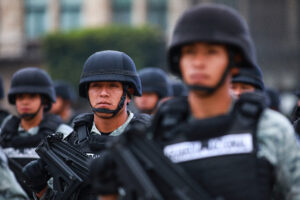1. Two separate studies conducted by international experts found no scientific evidence to substantiate the theory that the students had been burned at the trash dump in the nearby town of Cocula.
On January 27, 2015, then Attorney General Murillo Karam held a press conference to present the conclusions of the Mexican government’s investigation into the case of the students, reiterating the government’s theory that municipal police handed the students over to the “Guerreros Unidos” criminal group, who killed the students and burned their remains in the trash dump in Cocula. The members of Guerreros Unidos then gathered the remains, placed them in plastic bags, and dumped them in the San Juan River which is close to the town.
As part of its work to assist in the investigation, the Interdisciplinary Group of Independent Experts (GIEI) hired an internationally recognized fire specialist to examine the Cocula trash dump where the students were allegedly murdered and burned. This analysis, which was discussed in the Experts’ September 2015 preliminary report, did not uncover evidence of a fire large enough to cremate 43 bodies, nor evidence that sufficient materials were available in the area to fuel such a fire. Satellite images from the night of the students’ disappearance provided to the experts by the Mexican government in late 2015 do not show evidence of a fire in the trash dump on the night authorities claim the students were killed and incinerated, nor anywhere near the area. What’s more, a meteorological study even revealed that there had been rainfall in the area on the night of the students’ disappearance.
At the request of the victims’ families and their legal representatives, and with the Mexican government’s agreement, the Argentine Forensic Anthropology Team (Equipo Argentino de Antropología Forense, EAAF) a nongovernmental, independent team that provides forensic services in cases of human rights violations worldwide, began working on the investigation of the 43 disappeared students. The EAAF began its work on the case in early October 2014.
On February 9, 2016, after conducting its extensive forensic analysis of the Cocula trash dump, the EAAF concluded that there is no scientific basis to support the government’s trash dump theory. The EAAF’s main findingsare:
- There is a gap between witness testimony and the bullets and casings recovered at the trash dump. According to the alleged perpetratorsof the killings from the Guerreros Unidos criminal group, theyused handguns (.9mm and .38 super) and one AK-47-type rifle to kill the students. However, 87 percent of the bullets and casings recovered at the scene do not match these weapons; with just 16 casings corresponding to the specified guns. Additionally, none of these 16 casings were recovered at the exact location where the alleged perpetrators said they shot the students.
- According to satellite imagery and soil samples, multiple smaller-scale fires have occurred at the trash dump since at least 2010; however, there is no evidence of a fire large enough to incinerate 43 bodies.
- Plants at the alleged burn site in September 2014 (when the students remains were supposedly incinerated) could not have survived such a blaze, yet plant matter analyzed at the scene showed little to no signs of fire damage.
- While thousands of small, charred bone fragments were located at the trash dump, belonging to at least 19 individuals, there is no evidence linking these remains to the 43 students. Instead, evidence suggests that the trash dump had been the site of previous incinerations of human remains over the course of the past several years. The EAAF noted that there are complaints of at least 300 people who have disappeared around Iguala in the last five years.
2. There are alarming contradictions in the testimony provided by the suspects, and credible allegations that they were tortured.
Beyond the lack of matching bullets and casings,the testimonies of five suspects in the case are inconsistent. As the GIEI noted in their September 2015 report, these suspects’ claims include differences in how many students they reportedly apprehended, where the students were originally taken, and different versions about what happened when they arrived at the trash dump (like whether or not some of the students were already dead when they arrived, or whether they were handcuffed or not). The suspects also gave differing versions of how the students were killed and where, how their remains were incinerated, and when they allegedly took the remains from the students, placed them in bags, and dumped them in the San Juan River.
Medical reports by Mexico’s Attorney General’s Office show that 70 percent of the detainees in the case had injuries indicative of torture or mistreatment. The majority of the government’s evidence to support its “historic truth” about the trash dump was based on the confessions of the detained suspects.
3. The preliminary results of a separate March 2016 study by a fire analysis team agreed upon by both the GIEI and the Mexican government fails to provide evidence that the students’ were burned at the trash dump.
In spite of two independent scientific studies of the trash dump, the Mexican government insisted on having a third team of experts conduct another analysis. The government contracted a separate team to do this study, but signed a formal agreement with the Group of Experts about the conditions of the analysis. However, on March 31, 2016, Mexico’s Attorney General’s Office and a spokesperson of the fire analysis team, Dr. Ricardo Damian Torres, broke the terms of this agreement by holding a press conference to release preliminary findings of their study. Dr. Torres stated that they had found evidence of a large fire in the trash dump. However, he did not present information on when this fire could have occurred, whether it occurred the night of the student’s disappearance, and whether other fires could have occurred in the trash dump over the years, as the EAAF has stated.
Dr. Torres also stated that the remains of at least 17 people were found to have been burned in the trash dump. In their study, the EAAF found evidence of the remains of at least 19 people. However, as the EAAF’s notes, there is no evidence linking these remains to the students, or a way to ascertain whether all of the remains were placed in the trash dump at the same time and when this occurred. Dr. Torres failed to present new evidence in this regard. After presenting the preliminary results, Dr. Torres stated that more evidence was needed to confirm their hypotheses.


